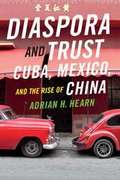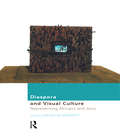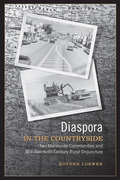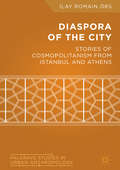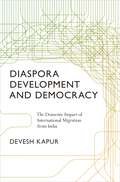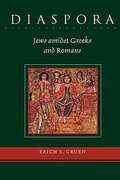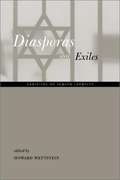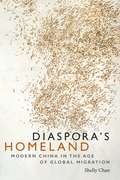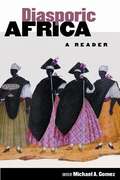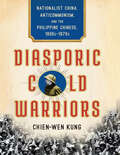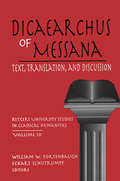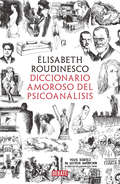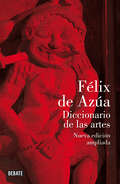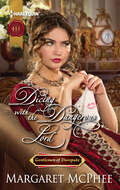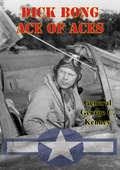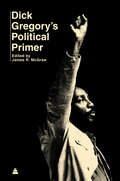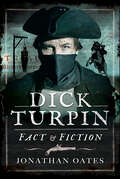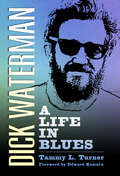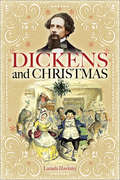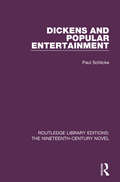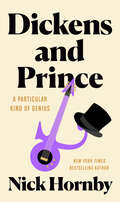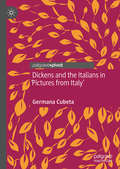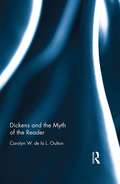- Table View
- List View
Diaspora and Trust: Cuba, Mexico, and the Rise of China
by Adrian H. HearnIn Diaspora and Trust Adrian H. Hearn proposes that a new paradigm of socio-economic development is gaining importance for Cuba and Mexico. Despite their contrasting political ideologies, both countries must build new forms of trust among the state, society, and resident Chinese diaspora communities if they are to harness the potentials of China's rise. Combining political and economic analysis with ethnographic fieldwork, Hearn analyzes Cuba's and Mexico's historical relations with China, and highlights how Chinese diaspora communities are now deepening these ties. Theorizing trust as an alternative to existing models of exchange--which are failing to navigate the world's shifting economic currents--Hearn shows how Cuba and Mexico can reformulate the balance of power between state, market, and society. A new paradigm of domestic development and foreign engagement based on trust is becoming critical for Cuba, Mexico, and other countries seeking to benefit from China's growing economic power and social influence.
Diaspora and Visual Culture: Representing Africans and Jews
by Nicholas MirzoeffThis is the first book to examine the connections between diaspora - the movement, whether forced or voluntary, of a nation or group of people from one homeland to another - and its representations in visual culture. Two foundational articles by Stuart Hall and the painter R.B. Kitaj provide points of departure for an exploration of the meanings of diaspora for cultural identity and artistic practice. A distinguished group of contributors, who include Alan Sinfield, Irit Rogoff, and Eunice Lipton, address the rich complexity of diasporic cultures and art, but with a focus on the visual culture of the Jewish and African diasporas. Individual articles address the Jewish diaspora and visual culture from the 19th century to the present, and work by African American and Afro-Brazilian artists.
Diaspora in the Countryside
by Royden LoewenFrom the 1930s to the 1980s, the North American countryside faced a profound cultural transformation in which a once-unified rural society became fragmented and dispersed. Families wishing to remain on the farm were required to accept new levels of automation, while others, unwilling or unable to make the change, migrated to nearby towns or regional cities. The cultural reformulation that resulted saw the emergence of a genuine rural diaspora. The growing cultural and physical separation was especially true for close-knit, ethno-religious communities, Mennonites, in particular. Forced into regional cities, the kaleidoscopic urban culture further fragmented the Mennonites into disparate social entities.In Diaspora in the Countryside, the phenomena of rural fragmentation is examined by comparing and contrasting two closely-related but distinctive Dutch-Russian Mennonite communities located in different parts of the continent: Kansas and Manitoba, respectively. By systematically comparing these communities, two distinctive responses to the mid-twentieth century 'Great Disjuncture' are made apparent. Royden Loewen also contrasts the cultural changes of these farm families to the cultures their kin adopted in nearby towns and cities. Loewen charts not only the dispersion of two rural communities, but follows their former residents as they reformulate their lives in new settings.
Diaspora of the City: Stories of Cosmopolitanism from Istanbul and Athens (Palgrave Studies in Urban Anthropology)
by İlay Romain ÖrsAs the former capital of two great empires—Eastern Roman and Ottoman—Istanbul has been home to many diverse populations, a condition often glossed as cosmopolitanism. The Greek-speaking Christian Orthodox community (Rum Polites) is among the oldest in the urban society, yet their leading status during the centuries of imperial cosmopolitanism has faded. They have even been brought to the brink of disappearance in their home city. Scattered around the world as a result of the homogenizing tendencies of nationalism, the Rum Polites in the diaspora of Istanbul (“the City” or Poli) continue to identify with its cosmopolitan legacy, as vividly shown through their everyday practices of distinction and cultural memory. By exploring the shifting meaning of cosmopolitanism in spatial and temporal contexts, Diaspora of the City examines how experiences of forced displacement can highlight changing conceptualizations of what constitutes a local, diasporic, minority, or migrant community in different multicultural urban settings, past and present.
Diaspora, Development, and Democracy: The Domestic Impact of International Migration from India
by Devesh KapurWhat happens to a country when its skilled workers emigrate? The first book to examine the complex economic, social, and political effects of emigration on India, Diaspora, Development, and Democracy provides a conceptual framework for understanding the repercussions of international migration on migrants' home countries. Devesh Kapur finds that migration has influenced India far beyond a simplistic "brain drain"--migration's impact greatly depends on who leaves and why. The book offers new methods and empirical evidence for measuring these traits and shows how data about these characteristics link to specific outcomes. For instance, the positive selection of Indian migrants through education has strengthened India's democracy by creating a political space for previously excluded social groups. Because older Indian elites have an exit option, they are less likely to resist the loss of political power at home. Education and training abroad has played an important role in facilitating the flow of expertise to India, integrating the country into the world economy, positively shaping how India is perceived, and changing traditional conceptions of citizenship. The book highlights a paradox--while international migration is a cause and consequence of globalization, its effects on countries of origin depend largely on factors internal to those countries. A rich portrait of the Indian migrant community, Diaspora, Development, and Democracy explores the complex political and economic consequences of migration for the countries migrants leave behind.
Diaspora: Jews amidst Greeks and Romans
by Erich S. GruenThe book reminds us there was a time in history when there was no anti-Semitism. Its virulent strain only broke out in the terrible race riot in Alexandria of 38 CE, when the Romans were already ruling the city and the Jews and the Egyptians were vying for their favor--and their jobs. The author explores the lives of these Jews, the obstacles they encountered, the institutions they established, and their strategies for adjustment. He also delves into Jewish writing in this period.
Diasporas and Exiles: Varieties of Jewish Identity
by Howard WettsteinAn interdisciplinary collection of broad-ranging articles on the topic of Jewish identity in the diaspora, based on the work of a fall 1997 UCHRI (University of California Humanities Research Institute, based at UC, Irvine) residential research group.
Diaspora’s Homeland: Modern China In The Age Of Global Migration
by Shelly ChanIn Diaspora’s Homeland Shelly Chan provides a broad historical study of how the mass migration of more than twenty million Chinese overseas influenced China’s politics, economics, and culture. Chan develops the concept of “diaspora moments”—a series of recurring disjunctions in which migrant temporalities come into tension with local, national, and global ones—to map the multiple historical geographies in which the Chinese homeland and diaspora emerge. Chan describes several distinct moments, including the lifting of the Qing emigration ban in 1893, intellectual debates in the 1920s and 1930s about whether Chinese emigration constituted colonization and whether Confucianism should be the basis for a modern Chinese identity, as well as the intersection of gender, returns, and Communist campaigns in the 1950s and 1960s. Adopting a transnational frame, Chan narrates Chinese history through a reconceptualization of diaspora to show how mass migration helped establish China as a nation-state within a global system.
Diasporic Africa: A Reader
by Michael A. GomezDiasporic Africa presents the most recent research on the history and experiences of people of African descent outside of the African continent. By incorporating Europe and North Africa as well as North America, Latin America, and the Caribbean, this reader shifts the discourse on the African diaspora away from its focus solely on the Americas, underscoring the fact that much of the movement of people of African descent took place in Old World contexts. This broader view allows for a more comprehensive approach to the study of the African diaspora.The volume provides an overview of African diaspora studies and features as a major concern a rigorous interrogation of "identity." Other primary themes include contributions to western civilization, from religion, music, and sports to agricultural production and medicine, as well as the way in which our understanding of the African diaspora fits into larger studies of transnational phenomena.
Diasporic Cold Warriors: Nationalist China, Anticommunism, and the Philippine Chinese, 1930s–1970s (Studies of the Weatherhead East Asian Institute, Columbia University)
by Chien-Wen KungIn Diasporic Cold Warriors, Chien-Wen Kung explains how the Chinese Nationalist Party (Kuomintang) sowed the seeds of anticommunism among the Philippine Chinese with the active participation of the Philippine state.From the 1950s to the 1970s, Philippine Chinese were Southeast Asia's most exemplary Cold Warriors among overseas Chinese. During these decades, no Chinese community in the region was more vigilant in identifying and rooting out suspected communists from within its midst; none was as committed to mobilizing against the People's Republic of China as the one in the former US colony. Ironically, for all the fears of overseas Chinese communities' ties to the PRC at the time, the example of the Philippines shows that the "China" that intervened the most extensively in any Southeast Asian Chinese society during the Cold War was the Republic of China on Taiwan. For the first time, Kung tells the story of the Philippine Chinese as pro-Taiwan, anticommunist partisans, tracing their evolving relationship with the KMT and successive Philippine governments over the mid-twentieth century. Throughout, he argues for a networked and transnational understanding of the ROC-KMT party-state and demonstrates that Taipei exercised a form of nonterritorial sovereignty over the Philippine Chinese with Manila's participation and consent. Challenging depoliticized narratives of cultural integration, he also contends that, because of the KMT, Chinese identity formation and practices of belonging in the Philippines were deeply infused with Cold War ideology.Drawing on archival research and fieldwork in Taiwan, the Philippines, the United States, and China, Diasporic Cold Warriors reimagines the histories of the ROC, the KMT, and the Philippine Chinese, connecting them to the broader canvas of the Cold War and postcolonial nation-building in East and Southeast Asia.
Dicaearchus of Messana: Volume 10 (Rutgers University Studies in Classical Humanities)
by Eckart SchütrumpfDicaearchus of Messana (fl. c. 320 b.c.) was a peripatetic philosopher. Like Theophrastus of Eresus, he was a pupil of Aristotle. Dicaearchus's life is not well documented. There is no biography by Diogenes Laertius, and what the Suda offers is meager. However, it can be ascertained that a close friendship existed between Aristoxenus and Dicaearchus as both are mentioned as personal students of Aristotle.Dicaearchus lived for a time in the Peleponnesus, and in his pursuit of geographical studies and measuring mountains, he is said to have enjoyed the patronage of kings. Dicaearchus's interests were in certain respects narrower than Aristotle's. There is no evidence that Dicaearchus worked in logic, physics, or metaphysics. To the contrary, his work On the Soul recalls the Aristotelian treatise of the same title, but Dicaearchus's work was not an esoteric treatise. Instead, it was a dialogue in two parts. His interest in good and bad lifestyles also found expression in works such as On the Sacrifice at Ilium, and On the Destruction of Human Beings, in which he presented man himself as the greatest threat to mankind. In On Lives, a work of at least two books, he considered philosophers and others noted for their wisdom, with his main thesis being the superiority of the active life over that of quiet contemplation. Cicero speaks of controversy between Dicaearchus and Theophrastus the former championing the active life and the latter that of contemplation. Circuit of the Earth was a work of descriptive geography in which Dicaearchus said that the earth has the shape of a globe. This interest in earth's sphericity led him to make maps and discuss other phenomena like the cause of ebb- and flood-tides and the source of the Nile River. The largest number of texts in the collection deal with cultural history, most of which stem or appear to stem from his Life of Greece, while the smallest section deals with politics.This tenth volume in the series Rutgers Studies in Classical Humanities includes a facing translation of the Greek and Latin texts, making the material accessible to readers who lack the ancient languages, and the accompanying essays introduce important issues beyond the scope of the text.
Diccionario amoroso del psicoanálisis
by Élisabeth RoudinescoUna vuelta por el mundo del psicoanálisis en 89 entradas. Entretenido y caprichoso, este Diccionario amoroso de Élisabeth Roudinesco invita a un recorrido fascinante: el que cruza al psicoanálisis como cultura a través de la historia, el cine, el arte, la geografía y las mitologías. El psicoanálisis, una suerte de nuevo mesianismo nacido en Viena a comienzos del siglo XX, se propuso encontrar una nueva tierra prometida: el inconsciente, la clínica de las neurosis y de la locura. Fenómeno urbano, representa una revolución de lo íntimo fundada en la actualización de los grandes mitos de la antigua Grecia. Anuncia que el hombre, aunque determinado por un destino, puede liberarse de sus cadenas pulsionales mediante una exploración de sí mismo, de sus sueños y sus fantasmas. ¿Una nueva medicina del alma? Sin duda, pero también un desafío al mundo de la racionalidad. Extraña disciplina, fue atacada por fanáticos religiosos, regímenes totalitarios y cientificistas preocupados por reducir al hombre a una suma de circunvoluciones cerebrales, al tiempo que era adulada por sus adeptos, cuyas jergas contribuyeron a menudo a degradarla. «En este Diccionario amoroso del psicoanálisis he adoptado el estilo de la lección -clasificar, reflexionar, distinguir, nombrar- a los efectos de explicarle al lector la forma en que el psicoanálisis se nutrió de literatura, de cine, de teatro, de viajes y de mitologías para llegar a ser una cultura universal. He atravesado ciudades y museos, me he encontrado con personajes, poemas y novelas [...] De Amor a Zurich, pasando por Animales, Buenos Aires, El segundo sexo, Sherlock Holmes, Hollywood, Marilyn Monroe, New York, Psique o Leonardo da Vinci, se encontrará aquí una lista de experiencias y palabras que permiten trazar la historia y la geografía de esta saga del espíritu en permanente metamorfosis.»
Diccionario de las artes (nueva edición ampliada)
by Félix de AzúaLa visión del arte de uno de los mejores escritores y más agudos pensadores de España. Diccionario de las artes es ya un clásico de la estética que ahora Félix de Azúa ha ampliado y revisado exhaustivamente para esta edición. A pesar de su título, el libro no es un diccionario al uso, sino un ensayo compuesto por diversas voces, dispuestas alfabéticamente, donde el autor medita acerca del ocaso del Arte. Para ello, regresa a los lugares del crimen, es decir, las artes y las ideas que han generado a lo largo de la historia, ese largo viaje en el que el hombre ha ido representándose y abstrayéndose a sí mismo hasta llegar a la extenuación actual. Con una estructura y un ritmo que recuerda a las variaciones musicales, Félix de Azúa, uno de los escritores más brillantes de nuestro tiempo, despliega el espectro semántico que ha generado el Arte y lo somete a una nueva formulación. La belleza, la muerte, lo sagrado o lo sublime se declinan en estas páginas a la par que se muestran los efectos, creativos o destructivos, del mercado, la publicidad y los medios de comunicación. Más que un ensayo de arte, Azúa ha concebido en esta obra imprescindible una bella y lúcida reflexión sobre la condición humana.
Dicing with the Dangerous Lord (Gentlemen of Disrepute #1125)
by Margaret McPheeTo solve her father’s murder, an alluring actress must play a deadly game of seduction in this sexy Regency romance.London, 1810. Venetia Fox is London’s most sought-after actress and every nobleman’s desire. But now, to bring her father’s murderer to justice, Venetia must face her toughest role yet: seducing a confession from the devilishly handsome and very dangerous Lord Linwood.The darling of the demimonde might have the whole of London fooled, but Linwood can see through Venetia’s ardent attempts to persuade him. His past is murky, but he’s no criminal. Her interest in him has Linwood intrigued—he might just have to play Miss Fox at her own seductive game. . . .
Dick Bong: Ace Of Aces
by General George C. KenneyMajor Richard "Dick" Ira Bong died at the tender age of 24 on the 6th August 1945 in a flight accident during testing of the P-80 Shooting Star Fighter. His fame was such that news of his death vied with the atomic bomb attack on Hiroshima in the US press, his legendary exploits at the helm of his P-38 Lightning had made him a household name. Bong had only recently received the Congressional Medal of Honor for his exploits of downing 40 enemy Japanese planes in the Southwestern Pacific. His tally of 40 victories made him the highest scoring American ace of all time, a record that is unlikely to ever be broken.In this biography his former commanding officer General George C. Kenney recounts his life; from his early life in Wisconsin, his sweetheart Marge, and his aerial exploits. Kenney enriches the narrative with personal anecdotes that illuminate the modest unassuming but determinedly heroic, Ace of Aces.Highly recommended.
Dick Gregory's Political Primer
by Dick Gregory James R. McGrawA unique and timeless guide to American government and its electoral process—as relevant today as when it was first published in 1972—from the voice of black consciousness, cultural icon Dick Gregory, the incomparable satirist, human rights and environmental activist, health advocate, social justice champion, and author of the NAACP Image Award–winning Defining Moments in Black History: Reading Between the Lies and the classic bestseller Nigger: An Autobiography.For most of his life, Richard Claxton “Dick” Gregory worked to educate Americans about the issues—and the forces of power—shaping their lives. A brilliant and informed student of the American experiment, he viewed and understood politics with an acuity few possess. Nearly fifty years ago, on the eve of Richard M. Nixon’s reelection, he wrote a classic guide to the American political system for ordinary folks. Today, when American democracy is threatened, his primer is more necessary than ever before. In Dick Gregory’s Political Primer, Gregory presents a series of lessons accompanied by review questions to educate and empower every citizen. He provides amusing, concise, and clear information and commentary on the nature of political parties, the three branches of government and how they operate, how the campaign process works and the costs, and more. Gregory offers imaginative comparisons such as the Hueys—Long, the populist Louisiana governor and Newton, the cofounder of the Black Panthers—and numerological parallels between Abraham Lincoln and John F. Kennedy. He also includes a trenchant glossary that offers insights into some of the major players, terms, and institutions integral to our democracy and government. An essential guide to American history unlike any other, Dick Gregory’s Political Primer joins the ranks of classics such as Howard Zinn’s A People’s History of the United States, and is essential reading for every American.
Dick Turpin: Fact & Fiction
by Jonathan OatesWhy does the notorious highwayman Dick Turpin have such an extraordinary reputation today? How come his criminal career has inspired a profusion of often misleading literature and film? This eighteenth-century villain is often portrayed as a hero – dashing, sinister, romantic, daring, a Robin Hood of his times. The reality, as Jonathan Oates reveals in this perceptive, carefully researched study, was radically different. He was a robber, torturer and killer, a gangster whose posthumous reputation has eclipsed the truth about his life. In the early 1700s Turpin progressed from butcher’s apprentice and poacher to become a member of the Gregory gang which terrorized householders around London by robbery and violence. Then came his two-year career as a highwayman robbing travelers, his partnership with Matthew King whom he may have killed in Whitechapel, his murder Thomas Morris in Epping Forest, and his eventual capture and execution. Jonathan Oates recounts the episodes in Turpin’s short, brutal life in dramatic detail, basing his narrative on contemporary sources – trial records and newspapers in particular – and he traces the development of the Turpin legend over 250 years through novels, ballads, plays, television and film. The Dick Turpin who emerges from this rigorous and scholarly biography is in many ways a more interesting man than the legend suggests.
Dick Waterman: A Life in Blues (American Made Music Series)
by Tammy L. TurnerGrowing up in an affluent Jewish family in Plymouth, Massachusetts, Dick Waterman (b. 1935) was a shy, stuttering boy living a world away from the Mississippi Delta. Though he never heard blues music at home, he became one of the most influential figures in blues of the twentieth century. A close proximity to Greenwich Village in the 1960s fueled Waterman's growing interest in folk music and led to an unlikely trip that resulted in the rediscovery of Delta blues artist Son House in 1964. Waterman began efforts to revive House’s music career and soon became his manager. He subsequently founded Avalon Productions, the first management agency focused on representing black blues musicians. In addition to booking and managing, he worked tirelessly to protect his clients from exploitation, demanded competitive compensation, and fought for royalties due them. During his career, Waterman befriended and worked with numerous musicians, including such luminaries as B. B. King, Buddy Guy, Taj Mahal, and Eric Clapton. During the early years of his career, he documented the work of scores of musicians through his photography and gained fame as a blues photographer. This authorized biography is the crescendo of years of original research as well as extensive interviews conducted with Waterman and those who knew and worked with him.
Dickens and Christmas
by Lucinda HawksleyDickens and Christmas is an exploration of the 19th-century phenomenon that became the Christmas we know and love today and of the writer who changed, forever, the ways in which it is celebrated. Charles Dickens was born in an age of great social change. He survived childhood poverty to become the most adored and influential man of his time. Throughout his life, he campaigned tirelessly for better social conditions, including by his most famous work, A Christmas Carol. He wrote this novella specifically to strike a sledgehammer blow on behalf of the poor mans child, and it began the Victorians obsession with Christmas.This new book, written by one of his direct descendants, explores not only Dickenss most famous work, but also his all-too-often overlooked other Christmas novellas. It takes the readers through the seasonal short stories he wrote, for both adults and children, includes much-loved festive excerpts from his novels, uses contemporary newspaper clippings, and looks at Christmas writings by Dickens contemporaries. To give an even more personal insight, readers can discover how the Dickens family itself celebrated Christmas, through the eyes of Dickenss unfinished autobiography, family letters, and his childrens memoirs.In Victorian Britain, the celebration of Christmas lasted for 12 days, ending on 6 January, or _Twelfth Night_. Through Dickens and Christmas, readers will come to know what it would have been like to celebrate Christmas in 1812, the year in which Dickens was born. They will journey through the Christmases Dickens enjoyed as a child and a young adult, through to the ways in which he and his family celebrated the festive season at the height of his fame. It also explores the ways in which his works have gone on to influence how the festive season is celebrated around the globe.
Dickens and Popular Entertainment (Routledge Library Editions: The Nineteenth-Century Novel #34)
by Paul SchlickeFirst published in 1985. Dickens was a vigorous champion of the right of all men and women to carefree amusements and dedicated himself to the creation of imaginative pleasure. This book represents the first extended study of this vital aspect of Dickens’ life and work, exploring how he channelled his love of entertainment into his artistry. This study offers a challenging reassessment of Nicholas Nickleby, The Old Curiosity Shop and Hard Times. It shows the importance of entertainment to Dickens’ journalism and presents an illuminating perspective on the public readings which dominated the last twelve years of his life. This book will be of interest to students of literature.
Dickens and Prince: A Particular Kind of Genius
by Nick Hornby&“An ardent fan letter from Hornby that makes you want to re-read Great Expectations while listening to Sign o&’ the Times.&” —VogueFrom the bestselling author of Just Like You, High Fidelity, and Fever Pitch, a short, warm, and entertaining book about art, creativity, and the unlikely similarities between Victorian novelist Charles Dickens and modern American rock star PrinceEvery so often, a pairing comes along that seems completely unlikely—until it&’s not. Peanut butter and jelly, Dennis Rodman and Kim Jong Un, ducks and puppies, and now: Dickens and Prince.Equipped with a fan&’s admiration and his trademark humor and wit, Nick Hornby invites us into his latest obsession: the cosmic link between two unlikely artists, geniuses in their own rights, spanning race, class, and centuries—each of whom electrified their different disciplines and whose legacy resounded far beyond their own time.When Prince&’s 1987 record Sign o&’ the Times was rereleased in 2020, the iconic album now came with dozens of songs that weren&’t on the original— Prince was endlessly prolific, recording 102 songs in 1986 alone. In awe, Hornby began to wonder, Who else ever produced this much? Who else ever worked that way? He soon found his answer in Victorian novelist and social critic Charles Dickens, who died more than a hundred years before Prince began making music.Examining the two artists&’ personal tragedies, social statuses, boundless productivity, and other parallels, both humorous and haunting, Hornby shows how these two unlikely men from different centuries &“lit up the world.&” In the process, he creates a lively, stimulating rumination on the creativity, flamboyance, discipline, and soul it takes to produce great art.
Dickens and the Bible: 'What Providence Meant' (ISSN)
by Jennifer GribbleAt a time when biblical authority was under challenge from the Higher Criticism and evolutionary science, ‘what providence meant’ was the most keenly contested of questions. This book takes up the controversial subject of Dickens and religion, and offers a significant contribution to the interdisciplinary area of religion and literature. In a close study of major novels, it argues that networks of biblical allusion reveal the Judeo-Christian grand narrative as key to his development as a writer, and as the ontological ground on which he stands to appeal to ‘the conscience of a Christian people’. Engaging the biblical narrative in dialogue with other contemporary narratives that concern themselves with origins, destinations, and hermeneutic decipherments, the inimitable Dickens affirms the Bible’s still-active role in popular culture. The providential thinking of two twentieth-century theorists, Bakhtin and Ricoeur, sheds light on an exploration of Dickens’s narrative theology.
Dickens and the Bible: 'What Providence Meant' (The Nineteenth Century Series)
by Jennifer GribbleAt a time when biblical authority was under challenge from the Higher Criticism and evolutionary science, ‘what providence meant’ was the most keenly contested of questions. This book takes up the controversial subject of Dickens and religion, and offers a significant contribution to the interdisciplinary area of religion and literature. In a close study of major novels, it argues that networks of biblical allusion reveal the Judeo-Christian grand narrative as key to his development as a writer, and as the ontological ground on which he stands to appeal to ‘the conscience of a Christian people’. Engaging the biblical narrative in dialogue with other contemporary narratives that concern themselves with origins, destinations, and hermeneutic decipherments, the inimitable Dickens affirms the Bible’s still-active role in popular culture. The providential thinking of two twentieth-century theorists, Bakhtin and Ricoeur, sheds light on an exploration of Dickens’s narrative theology.
Dickens and the Italians in 'Pictures from Italy'
by Germana CubetaThis work explores Dickens’s perception of Italy as it appears in the travel book Pictures from Italy. Corpus methodologies, alongside the notion of intersectionality, display the writer’s multi-faceted interpretation of the Italians and his efforts to highlight their multidimensionality and heterogeneity. The book debates that Pictures from Italy departs from conventions – it investigates the function of travel in the construction of Italian identity and discusses Dickens’s relationship with Italy. Corpus linguistics methodologies analyse the language of the book and shed newlight on the relationship between body language and culture.
Dickens and the Myth of the Reader
by Carolyn W. OultonThis study explores the ways in which Dickens’s published work and his thousands of letters intersect, to shape and promote particular myths of the reading experience, as well as redefining the status of the writer. It shows that the boundaries between private and public writing are subject to constant disruption and readjustment, as recipients of letters are asked to see themselves as privileged readers of coded text or to appropriate novels as personal letters to themselves. Imaginative hierarchies are both questioned and ultimately reinforced, as prefaces and letters function to create a mythical reader who is placed in imaginative communion with the writer of the text. But the written word itself becomes increasingly unstable, through its association in the later novels with evasion, fraud and even murder.
